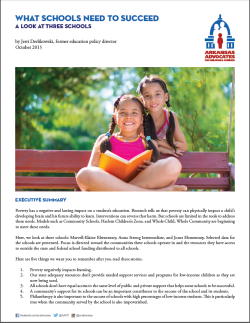
Poverty has a negative and lasting impact on a student’s education. Research tells us that poverty can physically impact a child’s developing brain and his future ability to learn. Interventions can reverse that harm. But schools are limited in the tools to address these needs. Models such as Community Schools, Harlem Children’s Zone, and Whole Child, Whole Community are beginning to meet these needs.
Here, we look at three schools: Marvell-Elaine Elementary, Anna Strong Intermediate, and Jones Elementary. Selected data for the schools are presented. Focus is directed toward the communities these schools operate in and the resources they have access to outside the state and federal school funding distributed to all schools.
Here are five things we want you to remember after you read these stories.
1) Poverty negatively impacts learning.
2) Our state adequacy resources don’t provide needed support services and programs for low-income children as they are now being used.
3) All schools don’t have equal access to the same level of public and private support that helps some schools to be successful.
4) A community’s support for its schools can be an important contributor to the success of the school and its students.
5) Philanthropy is also important to the success of schools with high percentages of low-income students. This is particularly true when the community served by the school is also impoverished.
All of our students, regardless of their zip code, deserve the highest quality classroom resources and high quality supports and opportunities outside the classroom that further support their learning. It will require the best strategies from all school leaders, policy makers, and private funding sources to meet these big challenges.
